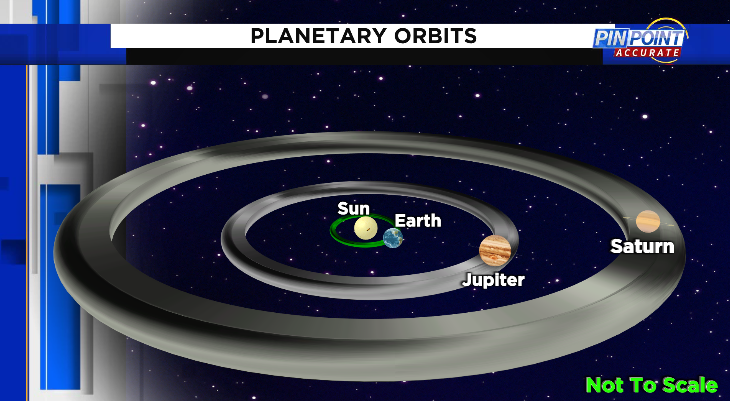The only planet whose center of mass in relation to the Sun lies outside the volume of the Sun is Jupiter. The mean distance from the Sun to Jupiter is 778,000,000 kilometers. It takes Jupiter 11.86 years to orbit around the Sun, so a typical year on Jupiter is 11.86 Earth years. This forms a 5:2 orbital resonance with Saturn because it is 2/5 the orbital period of the planet. Jupiter‘s elliptical orbit is inclined 1.31 degrees The elliptical orbit of Jupiter is inclined 1.31° compared to Earth. Jupiter’s eccentricity is 0.048.
Jupiter revolves or orbits around the Sun once every 11.86 Earth years, or once every 4,330.6 Earth days. Jupiter travels at an average speed of 29,236 miles per hour or 47,051 kilometers per hour in its orbit. The Galileo spacecraft, meanwhile, orbited Jupiter and its moons for nearly four years, beaming back to Earth thousands of pictures and a wealth of scientific data. Its two-year, primary mission ended in December 1997, but the mission was continued with an initial two-year extension. Jupiter, the most massive planet in the solar system and the fifth in distance from the Sun. It is one of the brightest objects in the night sky; only the Moon, Venus, and sometimes Mars are more brilliant. Jupiter takes nearly 12 Earth years to orbit the Sun, and it rotates once about every 10 hours. Io, another of Jupiter ’ s moons, a volcanic one, is also known to be hotter although the trade – off is that Io is also noted for producing high volumes of deadly sulfur. Were Earth to suddenly orbit Jupiter, then, we ’ d have to find a way of making heat without risking. After an almost five-year journey to the solar system’s largest planet, NASA's Juno spacecraft successfully entered Jupiter’s orbit during a 35-minute engine burn. Confirmation that the burn had completed was received on Earth at 8:53 p.m. EDT) Monday, July 4.
Because of this the distance between Jupiter and the Sun differs by around 75,000,000 km between its perihelion and aphelion. The perihelion is the nearest point and the aphelion is the farthest point of the planet when on the orbital path.
Jupiter’s axial tilt is small compared to its size. It is only 3.13 degrees. This is the reason why Jupiter has little seasonal changes when compared to that of Mars and Earth. Jupiter has the fastest rotation in all of the planets of the Solar System.
It rotates on its axis at less than ten hours, so a basic day on Jupiter is less than 10 Earth days. This is the reason for the equatorial bulge that can be seen from the earth through telescope. The rotation of Jupiter requires centripetal acceleration. Jupiter is not a completely solid body and because of this the upper atmosphere does its own differential rotation. Its rotation is five minutes longer than its equatorial atmosphere.

There are three systems that are used as frames of reference when graphing the movements of the features of Jupiter’s atmosphere. These are Systems I, II, and III, which are the latitudes on Jupiter’s surface.

Jupiter Orbital Speed
Jupiter: The Giant Planet
